
Swing Nikisha Williams’ star turn as Celie, a fabulous supporting cast, and imaginative staging make the Broadway Revival Tour of The Color Purple, Alice Walker’s powerful recounting of a young black woman’s road to self-discovery and self-assertion, well worth seeing despite a minimalist scenic design ill suited to (and volume levels turned way too low for) a hall as mammoth as the Segerstrom Center For the Arts.
Based on Alice Walker’s Pulitzer Prize-winning novel and its Steven Spielberg-directed film adaptation, the 2005 Broadway smash takes us on one African-American woman’s journey out of poverty and misery during the first half of the 20th Century.
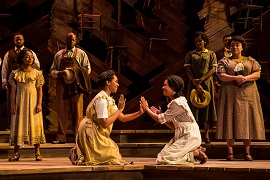 Filled with songs, laughter, and tears, The Color Purple benefits from Marsha Norman’s artful book, which manages to compact Walker’s 300-page epistolary novel with a minimum of dialog, the better to spotlight its over two dozen songs—music and lyrics by Brenda Russell, Allee Willis, and Stephen Bray—which run the gamut from gospel to R&B to blues to romantic ballads and back.
Filled with songs, laughter, and tears, The Color Purple benefits from Marsha Norman’s artful book, which manages to compact Walker’s 300-page epistolary novel with a minimum of dialog, the better to spotlight its over two dozen songs—music and lyrics by Brenda Russell, Allee Willis, and Stephen Bray—which run the gamut from gospel to R&B to blues to romantic ballads and back.
Walker’s story and Norman’s book introduce us to the same cast of characters we fell in love with in the 1985 movie, now given new resonance by the addition of song and dance.
Among those our plucky heroine encounters on the way to adulthood are Mister (Gavin Gregory), the hulking farmer who settles for marriage with Celie when her father refuses to let him wed Celie’s younger, prettier sister Nettie (N’Jameh Camara)—and then goes on to make Celie’s existence a living hell.
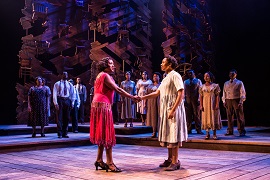 There’s also Mister’s longtime lover Shug Avery (Carla R. Stewart), the glamorous, sexy juke joint chanteuse who awakens Celie to her own beauty and self-worth.
There’s also Mister’s longtime lover Shug Avery (Carla R. Stewart), the glamorous, sexy juke joint chanteuse who awakens Celie to her own beauty and self-worth.
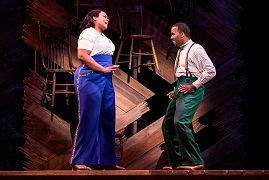 Meanwhile, the mountainous Sofia (Carrie Compere) earns Celie’s respect by proving via her marriage to Mister’s son Harpo (J. Daughtry) that a woman can fight back and win.
Meanwhile, the mountainous Sofia (Carrie Compere) earns Celie’s respect by proving via her marriage to Mister’s son Harpo (J. Daughtry) that a woman can fight back and win.
And then there’s Squeak (Erica Durham), the Minnie Mouse-voiced waitress who becomes Sofia’s rival for Harpo’s affections and inspires just one of the musical’s several knock-down-drag-outs.
Last but not least are the church ladies and field hands and night club habitués and others who make up Celie’s world from ages fourteen to fifty-four brought to life by the ten triple-threats first introduced to us in the musical’s infectiously hummable, clappable full-cast opening number “Mysterious Ways.”
Director John Doyle, whose actors-as-musicians approach to Sweeney Todd and Company earned him both diehard fans and detractors, takes on the challenge of stripping down-to-basics a Broadway show known for its spectacle with a scenic design that may have worked in the 180-seat West End theater where the Tony-winning Color Purple revival debuted but is considerably less successful in the 3000-seat Segerstrom Center.
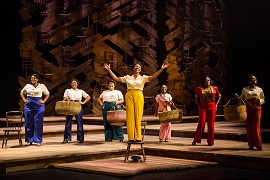 Doyle’s set consists of a proscenium-high wooden-slatted wall from which hang dozens of straight-back chairs … and that’s it from start to finish, meaning that unless you’re sitting in a prime orchestra seat, there’s little to capture the visual interest of anyone in a mezzanine (or God help them) a first or second balcony seat.
Doyle’s set consists of a proscenium-high wooden-slatted wall from which hang dozens of straight-back chairs … and that’s it from start to finish, meaning that unless you’re sitting in a prime orchestra seat, there’s little to capture the visual interest of anyone in a mezzanine (or God help them) a first or second balcony seat.
Director-choreographer Doyle does score sky-high points for his imaginative use of chairs brought down to stage level, not only moving them into one ingenious configuration after another but employing them as props in his infectious dance numbers as well, and lighting designer Jane Cox and costumer Ann Hould-Ward add flashes of color throughout.
Another clever touch is the use of long panels of cloth, folded to become Celie’s newborn and stretched out quite spectacularly in the tribal prints that make “African Homeland” a showstopper.
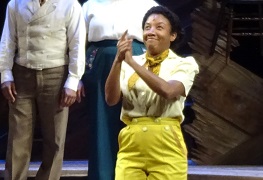 There can be absolutely no quibbling about performances on the Segerstrom Center stage beginning with Williams, prepped to go on in multiple female tracks and given her chance to thrill opening night audiences with a performance that like Celie herself, starts out quiet and restrained and then, as child bride acquires maturity and strength, takes triumphant flight in a stunning eleventh-hour declaration of independence (“I’m Here”) that earns Williams deserved cheers.
There can be absolutely no quibbling about performances on the Segerstrom Center stage beginning with Williams, prepped to go on in multiple female tracks and given her chance to thrill opening night audiences with a performance that like Celie herself, starts out quiet and restrained and then, as child bride acquires maturity and strength, takes triumphant flight in a stunning eleventh-hour declaration of independence (“I’m Here”) that earns Williams deserved cheers.
 Compere’s force of nature Sofia and Stewart’s fireball of a Shug deserve their own standing ovations as well, with Camara’s radiant Nettie, Gregory’s frighteningly intimidating Mister, Daughtry’s hopelessly henpecked Harpo, and Durham’s squeaky delight of a Squeak providing sensational support.
Compere’s force of nature Sofia and Stewart’s fireball of a Shug deserve their own standing ovations as well, with Camara’s radiant Nettie, Gregory’s frighteningly intimidating Mister, Daughtry’s hopelessly henpecked Harpo, and Durham’s squeaky delight of a Squeak providing sensational support.
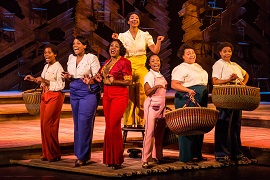 Ensemble members Darnell Abraham, Amar Atkins, Kyle E. Baird, Angela Birchett, Bianca Horn, Mekhai Lee, Gabrielle Reid, C.E. Smith, J.D. Webster, and Brit West do phenomenal work each and every one, with special snaps to Church Ladies Birchett, Horn, and West for their brief but frequent—and eagerly anticipated—appearances.
Ensemble members Darnell Abraham, Amar Atkins, Kyle E. Baird, Angela Birchett, Bianca Horn, Mekhai Lee, Gabrielle Reid, C.E. Smith, J.D. Webster, and Brit West do phenomenal work each and every one, with special snaps to Church Ladies Birchett, Horn, and West for their brief but frequent—and eagerly anticipated—appearances.
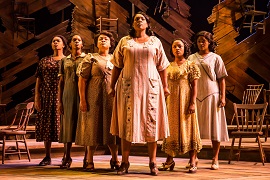 Wayne Green (at the performance reviewed) conducts The Color Purple’s Broadway-caliber orchestra. Darryl Archibald is musical director.
Wayne Green (at the performance reviewed) conducts The Color Purple’s Broadway-caliber orchestra. Darryl Archibald is musical director.
On a less positive note, sound designer Dan Moses Shreier keeps the volume so muted that audiences often must strain to decipher dialog, and his sound mix so over-amps the orchestra that vocal solos get drowned out.
Wig desginer Charles G. LaPointe, associate costume designer Christopher Vergara, and especially associate director Matt DiCarlo deserve their own kudos.
Melissa Chacon is production stage manager.
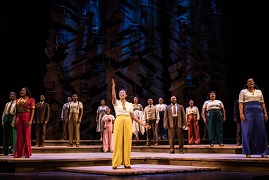 Filled with humor, heart, and hope, The Color Purple delivers the entertainment goods, and then some. The production design may not be what Broadway tour audiences deserve and the sound design is in serious need of adjustment, but if you don’t find yourself profoundly moved by Celie’s journey by performance’s end, then you’re made of stronger stuff than I.
Filled with humor, heart, and hope, The Color Purple delivers the entertainment goods, and then some. The production design may not be what Broadway tour audiences deserve and the sound design is in serious need of adjustment, but if you don’t find yourself profoundly moved by Celie’s journey by performance’s end, then you’re made of stronger stuff than I.
Segerstrom Center For The Arts, 600 Town Center Drive, Costa Mesa.
www.scfta.org
–Steven Stanley
June 19, 2018
Photos: Matthew Murphy
Note: Production stills feature Adrianna Hicks as Celie.
Tags: Alice Walker, Allee Willis, Brenda Russell, Marsha Norman, Orange County Theater Review, Segerstrom Center For The Arts, Stephen Bray



 Since 2007, Steven Stanley's StageSceneLA.com has spotlighted the best in Southern California theater via reviews, interviews, and its annual StageSceneLA Scenies.
Since 2007, Steven Stanley's StageSceneLA.com has spotlighted the best in Southern California theater via reviews, interviews, and its annual StageSceneLA Scenies.







 COPYRIGHT 2025 STEVEN STANLEY :: DESIGN BY
COPYRIGHT 2025 STEVEN STANLEY :: DESIGN BY